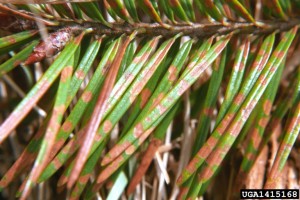Rhabdocline pseudotsugae

Andrej Kunca, National Forest Centre – Slovakia, Bugwood.org
Identification: Infected trees have thinned crowns and foliage with yellow spots. Infection occurs in new foliage in the form of small yellow spots ~1mm-2mm wide and then darkening to reddish orange in the winter. Small orange-brown Apothecia form from the spots on the leaves in the springtime and sporulate in may-june.
Hosts: Infects both the coastal and intermountain forms of Pseudotsuga menziesii (Douglas Fir). The disease is more common on the intermountain form.
Distribution: Found in many areas that contain Douglas Fir.
General Information: Douglas-fir needle blight is caused by a number of species and subspecies of the genus Rhabdocline. The most common in B.C. is R. pseudotsugae described here, andR. weirii (Parker & Reid). The symptoms caused by these organisms are similar, however, so precise identification is seldom important. Epidemic infection years occur in cycles and depend on climatic conditions during the infection period. Occasionally individual trees show marked resistance to the disease (1.).
References:
1. http://forestry-dev.org/diseases/ctd/Group/Needle/needle6_e.html
Leave a Reply